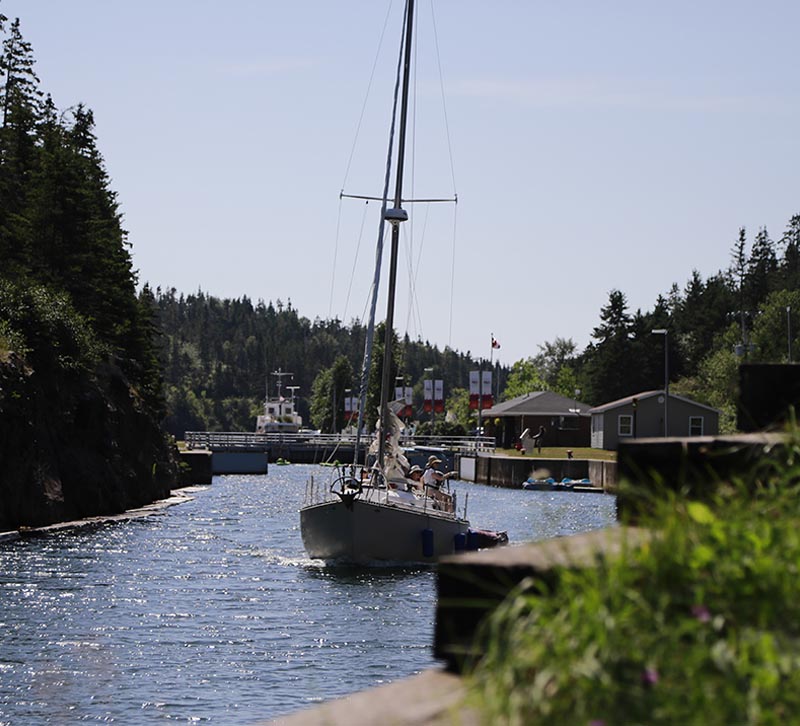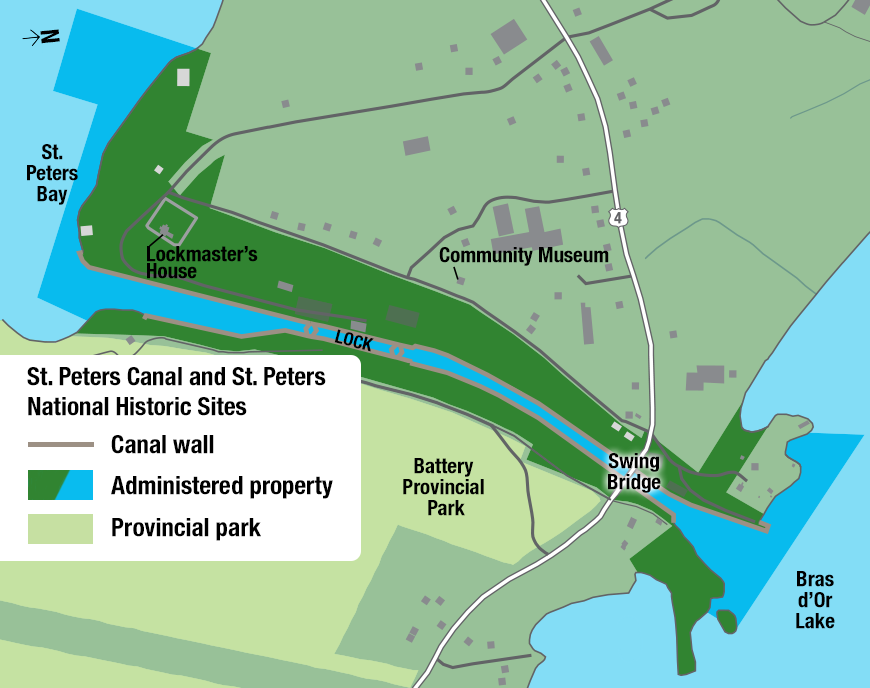St. Peters and St. Peters Canal National Historic Sites of Canada Management Statement, 2021
St. Peters Canal National Historic Site

Table of contents
Title: St. Peters and St. Peters Canal National Historic Sites of Canada Management Statement, 2021
Organization: Parks Canada Agency
Foreword

Minister of Environment and Climate Change and Minister responsible for Parks Canada
Canada’s national parks, national historic sites and national marine conservation areas belong to all Canadians and offer truly Canadian experiences.
These special places make up one of the finest and most extensive systems of protected natural and cultural heritage areas in the world.
The Government is committed to preserving our natural and cultural heritage, expanding the system of protected places and contributing to the recovery of species-at-risk. At the same time, we must continue to offer new and innovative visitor and outreach programs and activities so that more Canadians can experience Parks Canada places and learn about our environment, history and culture.
This new management statement for St. Peters and St. Peters Canal national historic sites of Canada supports this vision.
Management statements are developed through extensive consultation and input from various people and organizations, including Indigenous peoples, local and regional residents, visitors and the dedicated team at Parks Canada.
National parks, national historic sites and national marine conservation areas are a priority for the Government of Canada. I would like to thank everyone who contributed to this statement for their commitment and spirit of co-operation.
As the Minister responsible for Parks Canada, I applaud this collaborative effort and I am pleased to approve the St. Peters and St. Peters Canal National Historic Sites of Canada Management Statement.
Recommendations
Recommended by:
Ron Hallman
President & Chief Executive Officer
Parks Canada
Andrew Campbell
Senior Vice-President
Operations Directorate
Blair Pardy
Field Unit Superintendent
Cape Breton Field Unit
Introduction
Parks Canada manages one of the finest and most extensive systems of protected natural and historic areas in the world. The Agency’s mandate is to protect and present these places for the benefit and enjoyment of current and future generations. This management statement outlines Parks Canada’s management approach and objectives for St. Peters and St. Peters Canal national historic sites of Canada.
St. Peters and St. Peters Canal national historic sites are commemorated for their role as the site of Fort Saint-Pierre, a 17th-century fortified trading post acquired by Nicholas Denys to trade with the Mi’kmaq. In addition, they are commemorated as the site of Port Toulouse, a French community with a military presence that was witness to Anglo-French rivalry during the period 1713-1758. The Historic Sites and Monuments Board of Canada recommended both St. Peters and St. Peters Canal national historic sites for commemoration in 1929.
The area is significant to the Mi’kmaq people as it is the site of a former Mi’kmaq settlement, and was an important portage route for many generations prior to canal development. Several Mi’kmaq people were involved in building the canal. Although Parks Canada has compiled some information related to the importance of the sites to the Mi’kmaq, the current understanding is limited, and further understanding of the significance of these sites needs to be explored.
St. Peters and St. Peters Canal national historic sites are located in the Municipality of the County of Richmond on the southeastern shore of Cape Breton Island, and are part of the Cape Breton Field Unit of Parks Canada. The canal serves both pleasure craft and commercial vessels travelling to and from Bras d’Or Lake with approximately 1000 lockage services per year.
Management approach
Parks Canada will continue to manage St. Peters and St. Peters Canal national historic sites as an important navigational route for Cape Breton Island. Parks Canada will also ensure the commemorative integrity of these sites, working with the Mi’kmaq of Nova Scotia to review and update the commemorative integrity statements which document the sites’ national historic significance.
Parks Canada will continue to strengthen relations with Potlotek First Nation, the Village of St. Peter’s, community organizations, industry and the municipality to identify and collaborate on shared opportunities.
Management objectives
Building relationships with the Mi’kmaq of Nova Scotia
Parks Canada respects Aboriginal rights, including those identified within peace and friendship treaties, when building mutually beneficial relationships with Aboriginal communities, which is a priority for Parks Canada. In managing St. Peters and St. Peters Canal national historic sites, Parks Canada works with Mi’kmaq communities directly and through the Parks Canada-Mi’kmaq Unama’ki Advisory Committee to ensure that both western and Mi’kmaw knowledge inform site management, as well as reflect the values and cultural heritage of the Mi’kmaq people. Areas of interest moving forward include: reviewing and updating the commemorative integrity statements to reflect Mi’kmaq history and connections to the site; inclusive cultural resource management, including greater understanding of the history of the sites through collaborations in archaeology; cross-promotional visitor experience activities and potential employment or contracting opportunities.
Building relationships with local/regional partners
Parks Canada works cooperatively with St. Peter’s Economic Development Organization, Village on the Canal Association, Municipality of the County of Richmond and others to promote and deliver visitor opportunities at the sites, such as the Canal Landing, Lobsterfest, Swim the Canal and Pirate Days events.
Resource conservation
Parks Canada protects cultural resources at heritage places administered by the Agency in accordance with its Cultural Resource Management Policy and the Standards and Guidelines for the Conservation of Historic Places in Canada.
The statement of commemorative integrity and reasons for designation of St. Peters and St. Peters Canal national historic sites will be reviewed and updated collaboratively with the Mi’kmaq of Nova Scotia.
As well, recognizing that the sites have significance for the Mi’kmaq, Parks Canada commits to working with the Mi’kmaq of Nova Scotia to better understand and protect the values and cultural resources of Mi’kmaw significance at these sites, including from climate change impacts such as coastal erosion and sea-level rise.
Public understanding and appreciation
Parks Canada provides information about the significance of St. Peters and St. Peters Canal national historic sites on its website, through social media and on the Canadian Register of Historic Places. Parks Canada also delivers related outreach activities throughout Cape Breton, and has promotional information available at regional visitor information centres.
Canal services
Parks Canada continues to provide lockage services seasonally for vessels coming to and from Bras d’Or Lake.
Site maintenance
Parks Canada maintains the property it administers so as to respect the site’s heritage values, present a positive image to the public, and reflect the Parks Canada brand.
Summary of strategic environmental assessment
In accordance with The Cabinet Directive on the Environmental Assessment of Policy, Plan and Program Proposals (2010), a strategic environmental assessment is conducted on all management statements tabled in Parliament. The strategic environmental assessment for St. Peters and St. Peters Canal national historic sites assessed the potential effects on natural and cultural resources and visitor experience. The strategic environmental assessment concluded that the proposed management statement for St. Peters and St. Peters Canal national historic sites would have positive effects on cultural resources and visitor experience. Potential environmental effects on vegetation, species at risk, migratory birds and water quality were identified but the effects can be mitigated through project-level impact assessments when necessary. The Plan supports the Federal Sustainable Development Strategy goal of Connecting Canadians with Nature. There are no important negative environmental effects anticipated from management statement implementation.
Contact us
For more information about the management statement or about St. Peters and St. Peters Canal National Historic Sites of Canada, please contact:
St. Peters and St. Peters Canal National Historic Sites of Canada
P.O. Box 8
St. Peter’s, Nova Scotia, B0E 3B0
Canada
Email: pc.information.pc@canada.ca
St. Peters and St. Peters Canal National Historic Sites of Canada
Fax number: 902-295-3496
Publication information
© Her Majesty the Queen in Right of Canada, represented by the President & Chief Executive Officer of Parks Canada, 2021.
Front cover image credit: Parks Canada
Cette publication est aussi disponible en français.
- Paper: R64-581/2021E
- 978-0-660-31679-6
- PDF: R64-581/2021E-PDF
- 978-0-660-31677-2
Note to readers
The health and safety of visitors, employees and all Canadians are of the utmost importance. Parks Canada is following the advice and guidance of public health experts to limit the spread of COVID-19 while allowing Canadians to experience Canada’s natural and cultural heritage.
Parks Canada acknowledges that the COVID-19 pandemic may have unforeseeable impacts on the St. Peters and St. Peters Canal National Historic Sites of Canada Management Statement.
- Date modified :
